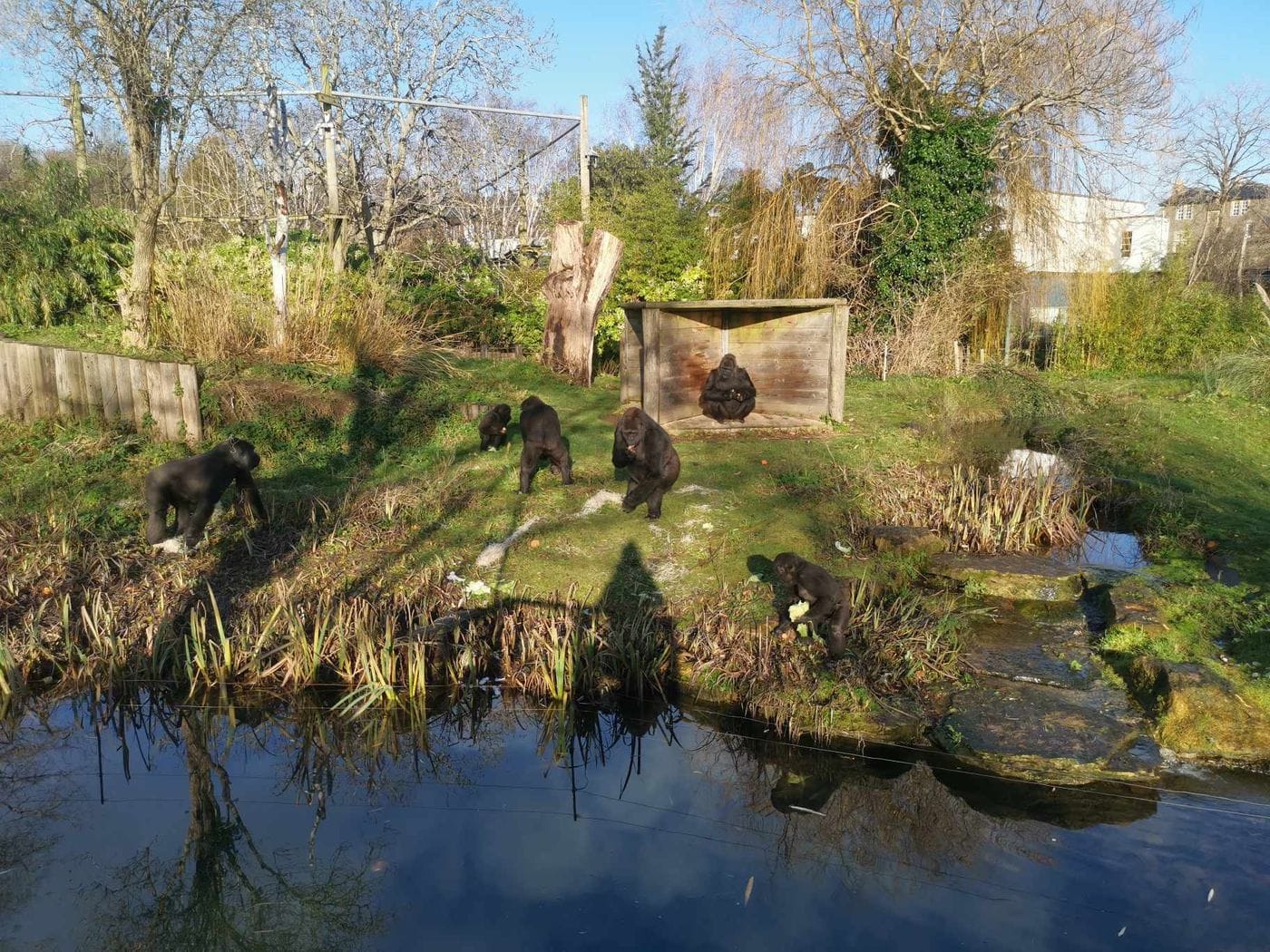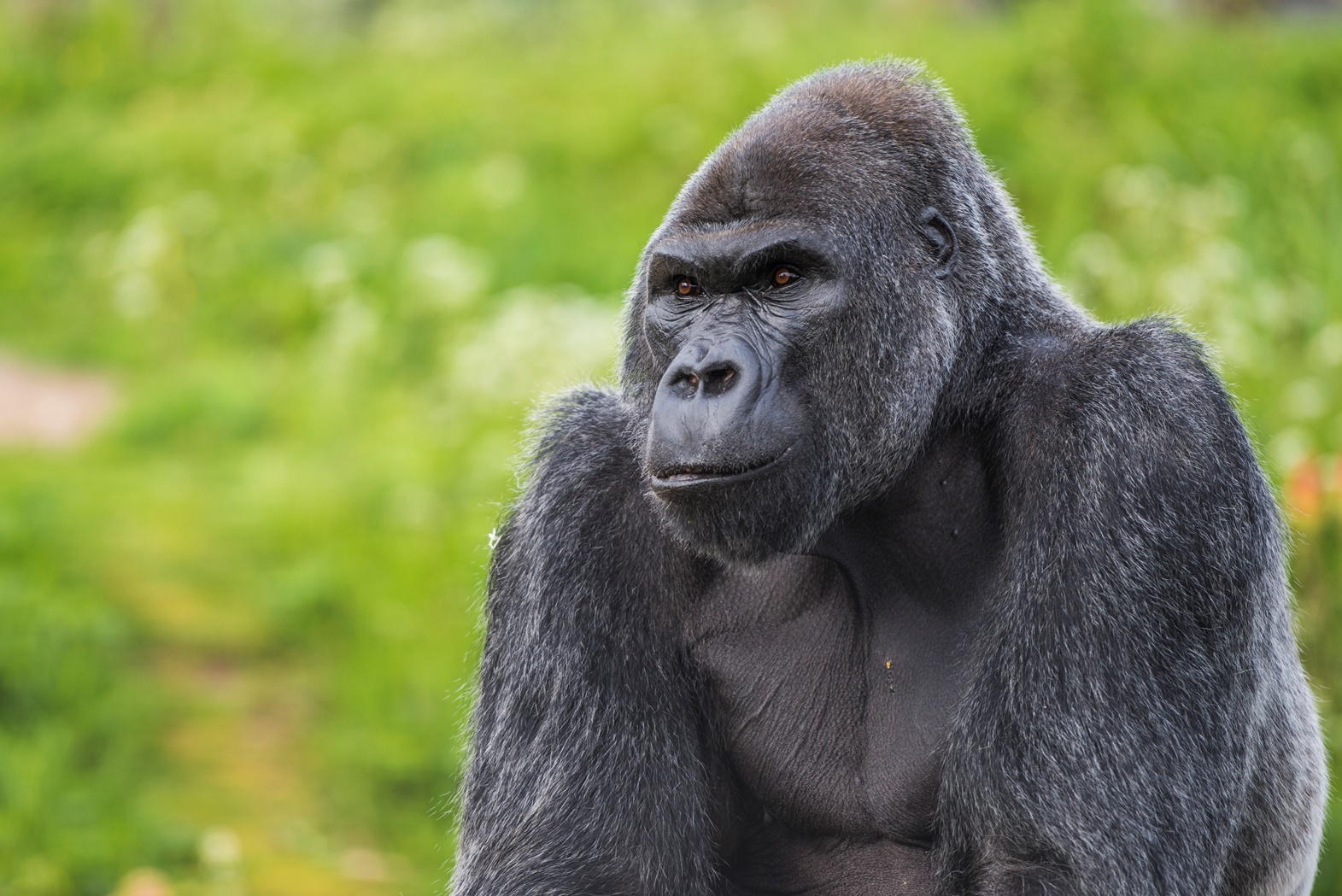
The fascinating behaviour of our gorilla troop
Posted on: 3 April, 2025
At Bristol Zoological Society, we’ve cared for gorillas for over 90 years, contributing to the European captive breeding programme, and helping to safeguard the future of this critically endangered species.
Our fantastic teams of experts, who have extensive knowledge of the species, care for and monitor our troop daily and can share some wonderful insights into the behaviours of this family group.
 Gorillas exhibit complex social behaviours, living in groups led by a silverback male, with strong bonds between family members, and engage in various social interactions from dominance displays to play.
Gorillas exhibit complex social behaviours, living in groups led by a silverback male, with strong bonds between family members, and engage in various social interactions from dominance displays to play.
At our Bristol Zoo Gardens site, the troop is led by Jock, our silverback male, who is the oldest male gorilla in the UK and the main decision-maker and protector of the group. Kera, Touni, and Kala are the adult females in the troop and have mothered many of those in the group. Ayana, 7, and Juni, 4 were born to Touni and Jock, Hasani, 4, to Kala and Jock, and Afia, 8, to Kera. All of the individuals have different relationships, and it’s fascinating to see how they interact depending on those bonds and connections.
Read more about our individual gorillas in our ‘Meet the troop’ blog.
 Many behavioural characteristics can be identified when monitoring the group, which include physical posturing, vocal communication, and play.
Many behavioural characteristics can be identified when monitoring the group, which include physical posturing, vocal communication, and play.
Firstly, a great deal of communication comes through posture, which can be both large and small. Super-subtle cues between the troop can include displacement, as well as the positioning of themselves closer to the silverback. In gorilla troops, you will often find the lower-ranking members further away from the silverback, but this is fluid and can very much change depending on how the females play the game. Here at Bristol Zoological Society, as a confident member of the group, Touni remains in a dominant position, Kala takes a more neutral approach and the clever and capable Kera tends to rank lower due to a more complicated relationship with the silverback.
 Gorillas will typically adopt a ‘power pose’ to display dominance. This usually involves standing in front of another gorilla whilst on all fours - did you know gorillas walk on their knuckles? In this position they would have stiff arms and an arched back in order to look big and impressive. Sometimes they’ll puff out their bottom lip and strut around a bit to make sure they’re getting the message across.
Gorillas will typically adopt a ‘power pose’ to display dominance. This usually involves standing in front of another gorilla whilst on all fours - did you know gorillas walk on their knuckles? In this position they would have stiff arms and an arched back in order to look big and impressive. Sometimes they’ll puff out their bottom lip and strut around a bit to make sure they’re getting the message across.
The gorillas also like to express themselves by occasionally ‘dressing up’, generally using foliage or their bedding. Most frequently seen in the juveniles and females, common accessories include the ever-popular ‘stick hat’, ‘straw scarf’ and ‘bedding veil’.
The younger ones in the group posture the most as they’re learning all the social cues and behaviours that they’ll need as adults. They also instigate a huge amount of play through posturing, hand clapping and chest-beating, with Juni being the most mischievous of them all.
Gorillas are not hugely expressive facially and tend to have a relaxed face when they are happy and content. The baring of teeth is a negative display, and a smile or grimace would be portrayed when they are scared.
They can also often be seen tucking their lips or hiding their teeth, which is a display of dominance and interpreted as a warning.
Vocalisations play a major part in communication between the troop, however, gorillas don’t have as many vocalisations as other apes. Grumbling is a frequent but nuanced vocalisation, conveying several different messages, from food grumbles, a “yum-yum” around certain foods, to a greeting and bonding signal. A lot of the females will grumble towards Jock and a majority of them will also grumble towards the fantastic team of keepers who care for them. Grumbling is a singing-like noise that shows excitement and each individual will often have their own style or melody. Afia definitely has the loudest of the troop in Bristol Zoo Gardens.
Grunting is another common and positive form of communication, which is more of a deep rumbling and di-syllabic sound that conveys contentment between individuals and would often be instigated by the silverback and followed by the rest of the group. When they’re heard to make a sound that resembles a cough, it is a “back off” communication and will often be around prized resources.
Gorillas love to laugh, especially when playing, tickling or wrestling with each other. Usually heard more often from the younger members when wrestling or being tickled by playmates, each individual has their own identifiable laugh.
When Jock feels like showing off to the females, he will generally ‘crescendo’ - a rolling, hooting noise accompanied by an impressive charge and chest slap, which tends to get a few grumbles from the ladies. In the wild, the bigger the chest and louder the noise the more likely the females will be attracted to the silverback.
 Finally, play is hugely important and very dependent on the individual, for example Jock isn’t the most playful of silverbacks, but others might play more. However, it’s safe to say that the rest of the group make up for it here at Bristol Zoo Gardens. Juni and Hasani, the two 4-year-old males, love to play and it’s extremely important for their development as they learn a lot about dynamics, cues, and boundaries. Witnessing play in a troop is very positive as it shows that they feel relaxed, which is even more apparent if seen between two unrelated females. Differences in play can often be identified between the two genders, with boys being more rough than younger females. Boys will often try to copy the actions of the silverback with charging motions and more wrestling, while female sub-adults begin to practice being mums by carrying babies on their backs.
Finally, play is hugely important and very dependent on the individual, for example Jock isn’t the most playful of silverbacks, but others might play more. However, it’s safe to say that the rest of the group make up for it here at Bristol Zoo Gardens. Juni and Hasani, the two 4-year-old males, love to play and it’s extremely important for their development as they learn a lot about dynamics, cues, and boundaries. Witnessing play in a troop is very positive as it shows that they feel relaxed, which is even more apparent if seen between two unrelated females. Differences in play can often be identified between the two genders, with boys being more rough than younger females. Boys will often try to copy the actions of the silverback with charging motions and more wrestling, while female sub-adults begin to practice being mums by carrying babies on their backs.
Child-like play tends to calm down after weaning, around the age of four or five, with females maturing earlier than males. This is reflected in the fading of the white spot on infants’ bottoms. The white spot is a helpful marker in the wild forests for mums to be able to find the young if they go too far from the troop, and to identify an individual as a vulnerable infant and to be treated as such.
 Every gorilla is unique and they all have their own characteristics, behaviours and ways of communicating. They’re a social unit of dynamic personalities that makes caring for them all that more rewarding. Being able to identify their differences ensures we can provide the best care and enrichment possible. For example, we know that Afia likes to use tools, Kera is a good problem solver, and Juni loves to make a mess and throw things around. When the moment arises that Jock lies down on his front in the sun, we know that he and the troop are fully relaxed.
Every gorilla is unique and they all have their own characteristics, behaviours and ways of communicating. They’re a social unit of dynamic personalities that makes caring for them all that more rewarding. Being able to identify their differences ensures we can provide the best care and enrichment possible. For example, we know that Afia likes to use tools, Kera is a good problem solver, and Juni loves to make a mess and throw things around. When the moment arises that Jock lies down on his front in the sun, we know that he and the troop are fully relaxed.
 Currently residing at Bristol Zoo Gardens, our troop of western lowland gorillas will move into the new African Forest habitat at Bristol Zoo Project this year when they will be introduced to a new group of Endangered cherry-crowned mangabeys that will live alongside them. African Forest will be open to the public in spring 2026.
Currently residing at Bristol Zoo Gardens, our troop of western lowland gorillas will move into the new African Forest habitat at Bristol Zoo Project this year when they will be introduced to a new group of Endangered cherry-crowned mangabeys that will live alongside them. African Forest will be open to the public in spring 2026.
As a conservation charity, we work in nine countries, across four continents, and direct 20 field conservation projects with 30 local partner organisations to conserve and protect some of the world’s most threatened species. We are protecting the wild populations in Equatorial Guinea through our project in Monte Alén National Park. We work with local communities to find ways for people to co-exist with the park’s wildlife, which includes the Critically Endangered western lowland gorilla and African forest elephant.
More information about our conservation projects in Equatorial Guinea and around the world can be found here.

Find out how you can help support the development of our troop's new home at Bristol Zoo Project below!

Want to help us save wildlife?
Become a member today for a year of wild adventure, and help protect the animals and habitats you love by supporting our conservation charity.

